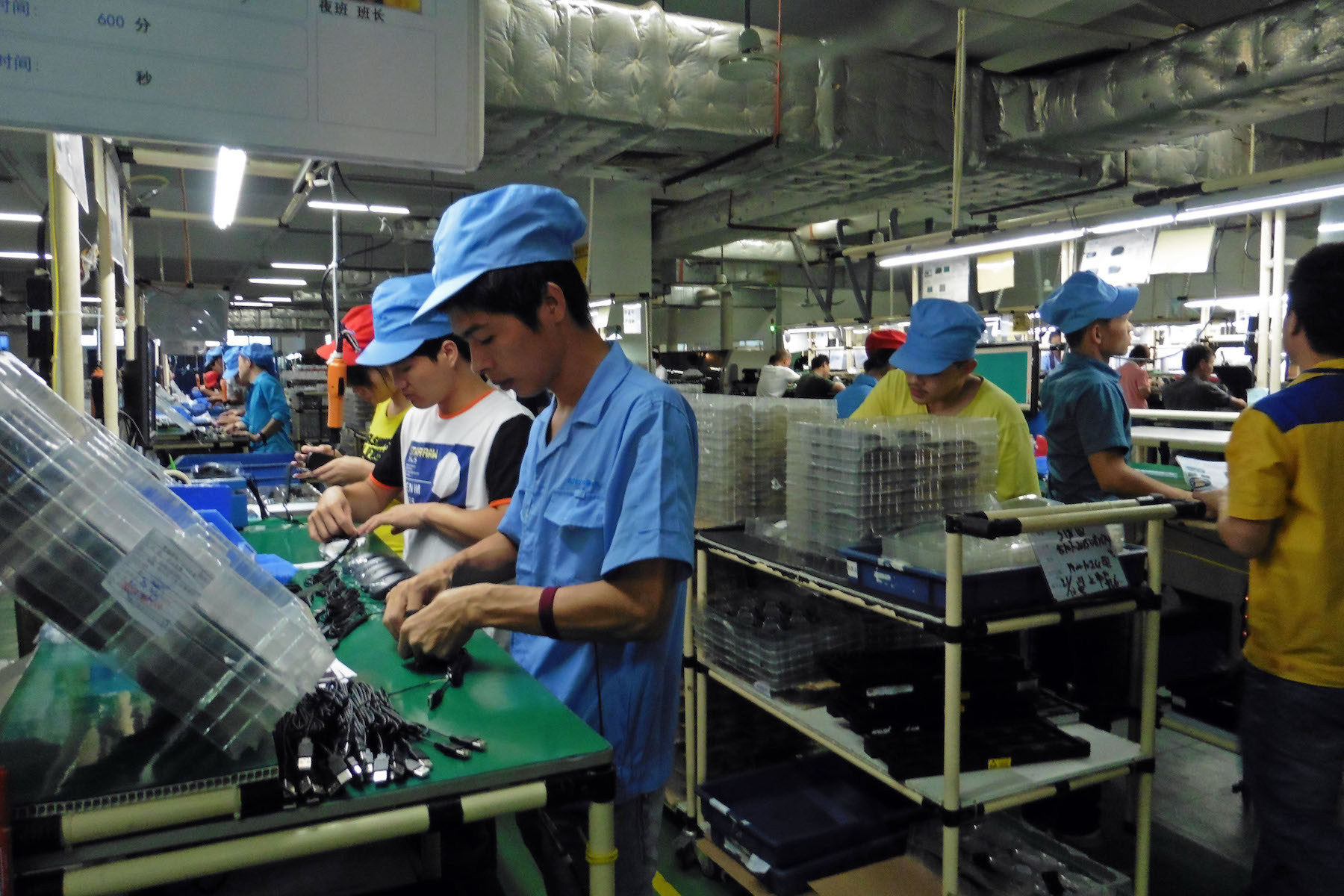The Electronics Industry Starts to Ease Out of China
The impacts of COVID-19 illustrate the risks involved in centering too much manufacturing, assembly, and intellectual property in one region. Yet the coming implementation of connected technologies, including automation, the Internet of Things, and 5G networks, depends on connectivity products that are currently made in China. Automation may be one way out.
The global electronics industry is deeply enmeshed in China. The COVID-19 pandemic, with its sociopolitical implications and supply chain disruptions, has underscored the inherent risks of centering so much critical business and intellectual property in this politically and economically complicated region.

Employees assemble computer peripherals at the G.Tech Technology factory in Zhu Hai, China. (Image courtesy of Chris from Shenzhen, China, per CC BY-SA 2.0)
For decades, U.S. and European companies have outsourced the manufacturing of massive amounts of goods to China, from textiles and pharmaceuticals to electronic components and computers. China’s economy exploded after its entry into the World Trade Organization in 2001, and U.S. companies flocked there to leverage a huge army of cheap workers; at that time, Chinese labor was less than $1 an hour. With 1.39 billion people, the Chinese market is also a major pull for global companies looking for new consumers. Historically, most companies underestimated the risks associated with Chinese government oversight, government-owned or controlled companies, and sharing intellectual property with Chinese partners. However, major companies, media organizations, academia, and even sports teams have encountered compromising situations as a result of their dealings in China. As we enter a decade in which connected technologies — including automation, the Internet of Things, Industry 4.0, and 5G networks — will profoundly shape the world, disconnecting from China is becoming an imperative.
Automation is a key technology that is reshaping nearly every industry, including manufacturing, energy, agriculture, logistics, building management, infrastructure, and service. The Internet of Things will connect equipment across homes and businesses. Industry 4.0 will automate manufacturing facilities. The implementation of 5G will enable the real-time communications needed for these technologies. To facilitate these systems, the connector industry needs to plan for next-generation designs compatible with massive robotic automation on both a micro- and macro-scale. Higher levels of integration are coming with 3-D, system-in-package (SiP), and package-on-package (PoP) semiconductor technology. This means that near-term future products can be modularized and made easier to automatically assemble, and that connectors will be needed to plug these modules together.
Secondly, and vitally important, is the coming robotic revolution, which needs to be addressed if Western economies are to remain competitive. Another evolving technology, silicon photonics, could revolutionize computing and communication products. The automotive industry has already adopted automated assembly processes, and must step up to adopt Industry 4.0 systems, including machine learning and data analytics, to develop smart factories for the coming electric vehicle revolution. Without stifling innovation or moving down the wrong fork in the road, governments must encourage adoption of these advanced manufacturing technologies in the U.S. and Europe; centering it all in China exposes other countries to considerable risk.
Automated robotic assembly (left) and silicon photonics technologies (right) are revolutionizing manufacturing and will be key to remaining competitive in the global market over the coming years. (Silicon photonics wafer image courtesy of Ehsanhahoseini per CC BY-SA 4.0).
The entire global electronics supply chain has become dependent on a single country that controls key materials, manufacturing processes, and intellectual property.
- China dominates strategic rare earth materials used in mobile electronics and vehicle batteries.
- China has emerged as the world leader in electric vehicles and solar panel technologies.
- Many industry-standard connectivity products are manufactured and assembled in China.
- Semiconductor OEMs are going fabless (contracting out their production), mostly to Asia. China looms as the next IC destination.
- OEMs are outsourcing to Asian subcontractors, EMS, and ODM suppliers such as Foxconn, Quanta, and Pegatron.
- Nearly all PCBs, X86 servers, and data communications equipment are manufactured in Asia.
- Board assembly equipment is centered in China, to the detriment of any high-volume assembly left in North America or Europe.
- Chinese assembly hubs are entwined with local supply depots and factories for all suppliers, including connectors and cable assemblies.
However, there are signs that some global companies are trying to deleverage themselves from China. Amazon, Apple, Dell, Google, HP, and IBM have all quietly explored other venues to manufacture their products. Vietnam, India, Eastern Europe, Central America, and South America are increasing their manufacturing capabilities, and some higher-ticket items are being made in North America. As much as a third of what is now outsourced to China could go elsewhere, with more possible if the current situation deteriorates.
This results in a dilemma for electronic component suppliers. Many companies are heavily invested in China to support OEM/ODM manufacturing campuses there. They need to stay close to their customers and determine where to move manufacturing or supply depots to support customers with just-in-time parts delivery. Export to trade-friendly countries such as Mexico, Brazil, or Argentina, where OEMs can reside with minimal government interference and access low-wage workers, may be a possibility. India has a huge potential workforce with an ample supply of tech-savvy personnel. However, its infrastructure is inadequate; although Samsung does assemble phones there, and a few companies have assembled PCs in India. The ultimate choice would be to beef up automated manufacturing in the U.S., U.K., and Europe. Yet the realities of reshoring, including Western labor costs and the need for government subsidies, are complex. Foxconn’s experience so far does not bode well for relocation to the U.S., where Foxconn promoted unrealized manufacturing sites in Wisconsin and Pennsylvania.
Some predict China is ripe for a fall. It will lose some Western manufacturing, and possibly a greater economic crisis is looming. Many of its companies are highly leveraged and under the wing of Central Planning, a practice which has a history of picking losers. China is also strangling under a pile of debt, which hit 317% of GDP in 1Q20 and does not count debt in municipalities and in the private sector. The situation is volatile.
Domestic manufacturing is still theoretically preferred by U.S. and European governments and consumers. Some servers, storage, and high-end datacom equipment is produced in the U.S., but most consumer electronics, including mobile phones, PCs, peripherals, and networking equipment, are made in Asia. Since many Western electronics manufacturers use ODMs in Taiwan, the domestic EMS industry has migrated to high-end products, concentrating on more profitable markets such as automotive electronics, high-end computers and storage equipment, and medical electronics. Gearing up to assemble millions of phones or laptops in the U.S. is doable, but at potentially unacceptable higher costs. Only one company is making phones in Germany. This is a major roadblock unless investments can be made in high levels of automation. Domestic EMS suppliers may also not be financially capable of the large investments needed to automate, as they operate on thin margins. Board assembly using high-speed chip shooters and surface mount assembly is possible outside of Asia, but auto-connecting subassemblies with WTB and BTB connectors and cables is still mainly an operator’s job. Although, it is doable with advanced robotic assembly techniques that will ultimately be needed for Western economies to remain competitive. The best solution for U.S. and European manufacturers is to use higher levels of integration, leveraging our lead in semiconductor technology. If subassemblies for logic, memory, solid-state storage, and other functions can be integrated into pluggable modules, there is hope for a future domestic assembly industry that minimizes packaging costs through monolithic and SiP/PoP technology.
To establish independence from China, Western businesses need to pursue automated manufacturing and robotics. China is investing heavily in a future automated manufacturing regime. The country already has a few “lights-outs” or fully automated electrical and electronics factories. More will come.
Like this article? Check out our other forecast, manufacturing, and Facts & Figures articles, our Industrial Market Page, and our 2020 and 2019 Article Archives.
- Electric Vehicles Move into the Mainstream with New EV Battery Technologies - September 7, 2021
- The Dynamic Server Market Reflects Ongoing Innovation in Computing - June 1, 2021
- The Electronics Industry Starts to Ease Out of China - November 3, 2020





